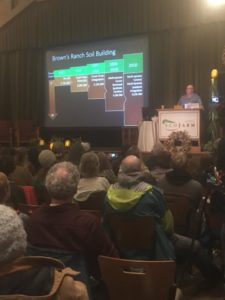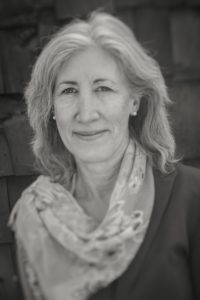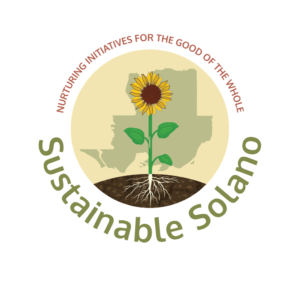Feb 1, 2018
by Stephanie Oelsligle Jordan, Sustainable Solano, Local Food System Manager
This was my first EcoFarm conference. When initially sifting through the options for lectures and discussions about a month ago, I noticed the obvious: “how-to” workshops on various technicalities of farming, and peer discussions on what works (or doesn’t) in agriculture today, new inventions, pest management, etc. What I wasn’t expecting were some amazing and relevant discussions and speeches addressing how today’s farmers must intersect with larger social/world issues including hunger, social justice in food systems, honoring Native American lands, and climate change, just to name a few.
But there was another underlying, somewhat spiritual theme that seemed to arise from the workshops and discussions that I attended: our relationship to – and responsibility for – a given place, whether we farm it or not. It was this “sense of place” that I found myself thinking about the most, and how that idea might serve my work with Sustainable Solano’s Local Food initiatives.
I am not an expert in Permaculture or Biodynamic farming (I’m a chef!) but I gathered that this “sense of place” is vitally important in both methods of farming. In a talk titled “Nature Connection, Permaculture & Ecological Responsibility,” Will Scott of Sonoma’s Weaving Earth Center for Relational Education took us on a journey both inside our minds and hearts, and then – literally – out into the woods. His initial argument was that “our sense of awareness of our landscape and surroundings has been limited by the industrialized world….The mind has been colonized, and the story of separation has been ingrained….Modern experience has atrophied our ‘whole being sense.’” But all is not lost!
Through “Nature Connection,” we can regain our sense of connection. He made an interesting point (often forgotten, I might add) that our connection to the natural world just IS. We can’t deepen it. However, we can increase our capacity to interact with it and relate to it. “When love for a place happens,” he stated, “empathy is embodied and behavior can change to ensure the place is taken care of….If we want to start designing or thinking ‘whole system’, then we need to use our whole system too: heart and mind, and not just our intelligence.” He had a quote from someone else, which pretty much summed it up: “Lose your mind and come back to your senses!” So we did. He led us out to the woods, and for about 10 minutes we did nothing but let nature interact with our 5 senses, in what he called a “Sit Spot.”
Another workshop that touched upon this “sense of place” was a discussion group titled “Biodynamic Farming and Gardening for the Future”. Seasoned biodynamic farmers and newcomers to the method were sitting in a circle, and I was struck by one farmer who had previously farmed in Wisconsin. He had lately moved to California, and just wasn’t connecting to the land like he had in the Midwest. (This is a problem, by the way, if you want to be a biodynamic farmer!) As I learned about the importance of the farmer’s interaction with not only the land, but also the solar system, weather patterns, creatures big and small, and everything else in his/her “place,” I began to wonder about the rest of us. Is there a way to connect non-farmers to the land/place through the food?
This question also came up for me at a couple of workshops on Community Supported Agriculture (CSA) programs. As you’d guess, the CSA discussions were largely about how to acquire and retain subscriptions. After addressing the logistical issues (marketing, surveys, packaging, software, etc.), the group concluded that 1) education about CSAs was important and 2) people want a connection to local farmers. Here’s that connection theme again!
The final talk I attended was titled “The Farmer and the Chef: Utilizing Abundance” (Finally! Something I understand!) and featured exactly that: Farmer Jeff Dawson of The Farm in Woodside, CA and Chef Stuart Brioza of State Bird Provisions and The Progress restaurants in San Francisco. Here they were, presenting their collaboration, along with all the spreadsheets and systems that have made it work over the past 5 years. This is admittedly a very specialized relationship, in which the majority of us will not experience. However, Chef Brioza made a good point, which is not unlike the CSA programs, and has this idea of connection at heart: “You’re not just partnering with a farm. You’re partnering with abundance, and the harvest….We are telling a story about the farm, on the plate.”
I’m sure I left EcoFarm with more questions than answers. (How can the larger population become involved in that “sense of place” in order to appreciate the value of the farmer’s work? How can this “sense of place” influence our local farmers to take better care of their soil? How are we ALL responsible for this place, whether we farm it or not?) And I think most of the attendees may have left with more questions as well. However, I sensed an energy among all of us that in the midst of all the questions, we all had an unwritten and unspoken commitment to one another to move forward. Everyone seemed courageous….ready to make connections….and do what it takes to care for their respective places on the planet.
Made possible by Solano Public Health in partnership with the Yocha Dehe Wintun Nation
Feb 1, 2018
By Elena Karoulina, Executive Director, Sustainable Solano
 At the end of January, I was honored to attend the 38th Eco Farm Conference at Asilomar Conference Grounds. It’s an annual convergence of farmers, supporting people and organizations dedicated to “ecological farming” – farming that works in harmony with nature, that seeks to heal and regenerate our land and water, and to provide wholesome, nurturing food to our communities. Sustainable Solano is beginning to work toward the vision of a healthy and whole local food system in the county, and we welcome this opportunity to learn from the field and bring this knowledge back to Solano County.
At the end of January, I was honored to attend the 38th Eco Farm Conference at Asilomar Conference Grounds. It’s an annual convergence of farmers, supporting people and organizations dedicated to “ecological farming” – farming that works in harmony with nature, that seeks to heal and regenerate our land and water, and to provide wholesome, nurturing food to our communities. Sustainable Solano is beginning to work toward the vision of a healthy and whole local food system in the county, and we welcome this opportunity to learn from the field and bring this knowledge back to Solano County.
Farm as a living organism, in harmony with nature and people, regenerating its own vitality and fertility on site
The central pole of the conference was sustainable agriculture – why, and most importantly, how. “Regenerating Our Soils” keynote opened the event, followed by many workshops on soil health and building soil fertility directly on the farm and not from the outside in the form of fertilizers, pesticides and herbicides. Healthy soil is the foundation of sustainable agriculture. Cover crop and crop rotation, incorporating animals into farming operations (manure has been the foundation of land’s fertility since humanity began farming 12,000 years ago), no-till approach, composting – all this and more was presented by experienced farmers and scientist now proving in their labs what has been known around the globe for centuries. This attention to soil health is reinforced by our recent realization that improving soil health can reduce greenhouse gas emission and sequester carbon!
Farming workshops included a wide range of topics on plants nutrition, selection, health and diseases; classes on specific crops, irrigation, tools and machinery, greenhouses, seeds and seed saving. Permaculture and biodynamic agriculture were examined through numerous workshops and gatherings. Urban agriculture was included too – an inspiring example from our neighbors in Richmond, Urban Tilth.
“People in communities like Richmond are treated only as consumers, meant to consume the products that others create to help them realize their dreams, and help us continue with our grind. They give just enough to continue, but no more.” Keynote speaker Doria Robinson, Urban Tilth, Richmond, CA.
The next big topic was how to get this wonderful harvest to local communities. Almost a dozen of workshops dedicated to delivery and logistics solutions, Community Supported Agriculture, small independent retails stores and food co-ops, working with restaurants, food safety, and utilizing social media.
And then came everything that surrounds farming: land use, social justice, legal and financial constraints and considerations, farmland protection and farmers’ succession, and food policies – from a Farm Bill to state policies to local laws and ordinances, including zoning. One of the big takeaways for me was the notion of how quickly we are loosing farmland to development, land hoarding and speculation. Representatives from the Sustainable Economies Law Center (our partners in the development of Solano Local Food System!), California FarmLink, California Center for Cooperative Development, various land trusts and legal firms discussed options for farmland protections and creative funding to remove farmland from speculative real estate market and protect it forever for agriculture. Traditional land trusts, emerging affirmative agricultural easements, community land trusts – these and other legal forms were examined at length.
There is no planet B.
Inspiring key speakers kept all of us attuned to the vital importance of this work and kept things in perspective by returning us to big picture. Winona LaDuke spoke beautifully about sacred land and practices of native people, new economy, environmental justice and a choice between a well-worn, scorched path and a new, green path ahead of us. Dr. John Ikerd masterfully outlined the devastation caused by industrial agriculture and promise of small farms and ecological farming to finally end hunger. John argued that healthy food is a fundamental human right, and since market economy failed our food system, local jurisdictions can declare basic food to be a utility and thus be provided to all people as basic services, just like water or energy.
After these three days of intense learning and networking, going from inspiration to despair and back to resolve to make a difference, we returned home ready to tackle the most important, fundamental and life-giving area of our lives – healthy local food for all.
Made possible by Solano Public Health in partnership with the Yocha Dehe Wintun Nation
Jan 30, 2018

Sustainable Solano is expanding its Sustainable Backyard and Conversations programs into Suisun City bringing informative workshops on sustainable landscaping and inspiring talks on topics such as global sustainability, community resilience, permaculture, local food systems and sustainable landscape design.
On Saturday, February 3rd at the Suisun Harbor Theater (720 Main Street, Suisun City) author, permaculture expert and former elected official (Lake County Board of Supervisors) Denise Rushing will launch the official expansion with an evening of conversation on how to create resilient, cooperative communities through meaningful and inspiring human-scale initiatives using social permaculture principles.
As a pioneer in environmental advocacy, Denise has devoted her life to transforming humanity’s relationship with Earth and has spearheaded numerous community revitalization efforts across the Western United States. Attendees of this FREE event will learn creative ways to invest personal energy to engage and transform local neighborhoods from the grassroots by choosing projects that are fun and have the potential to connect across the spectrum.
Registration is required for this FREE event. Click here to register.
The Sustainable Backyard and Conversations program will expand to Vacaville in the fall of 2018. Visit our calendar and follow us on Facebook for updates and details about this expansion.
Jan 16, 2018

Looking to help make an impact for a cause that matters to you in your community? The Center for Volunteer & Nonprofit Leadership (CVNL) has created an interactive Volunteer Portal where nonprofits and individuals can easily create a free online profile to match agency needs to volunteer interests. Click here to create your profile and browse nonprofits in your city working to improve the community.
Volunteers play a vital role in the delivery of our mission and there are plenty of ways that you can get involved! Click here to see Sustainable Solano’s current volunteer opportunities.
Have questions about CVNL or need help creating your profile? Contact Tina at tchechourka@cvnl.org.
Jan 16, 2018


Sustainable Solano hosted its first rainwater barrel collection workshop, sponsored by the Solano County Water Agency, this month with a successful turnout of Vallejo residents interested in harvesting every drop possible during the rainy season. The workshop offered an informative lecture about the state’s current water situation, various rain harvesting methods and hands-on training on how to build a home rain barrel system.
Diablo Valley College (DVC) Horticulture Department instructor Steve Torres stressed the importance of conserving water during these wetter months and as 63% of California’s population is still being impacted by the recent drought (drought.gov).
On average, each person uses about 80-100 gallons of water per day. Rainwater harvesting can significantly help reduce use of potable water within the household and gardens. Techniques used for collecting, storing and using rainwater for landscape irrigation and other uses include roof catchment, gutter and downspouts, storage containers (cisterns, barrels, etc.) and disperse water.
Attendees participated in the construction of a barrel system using recycled plastic containers. Clean, untreated wooden wine barrels may also be used for catchment. Rain barrels were available for purchase and participants were provided their very own USB flash-drive containing over 100 bonus slides of photos and detailed descriptions of how to build all rainwater capture methods covered in this workshop.

 At the end of January, I was honored to attend the 38th
At the end of January, I was honored to attend the 38th 



